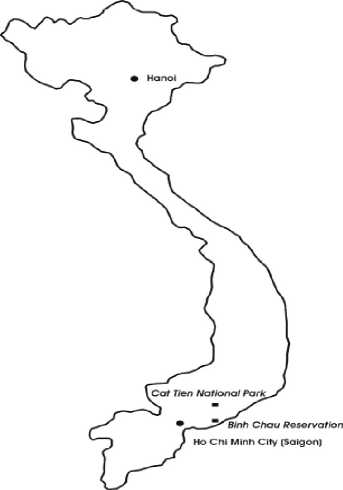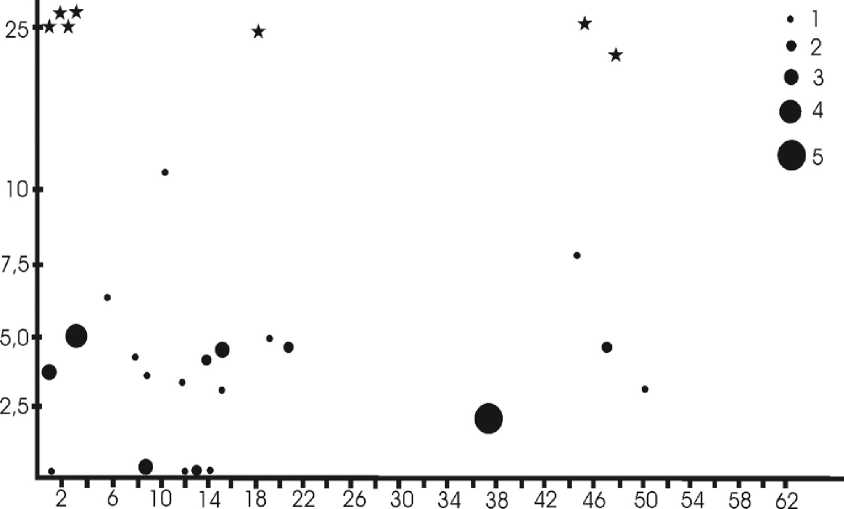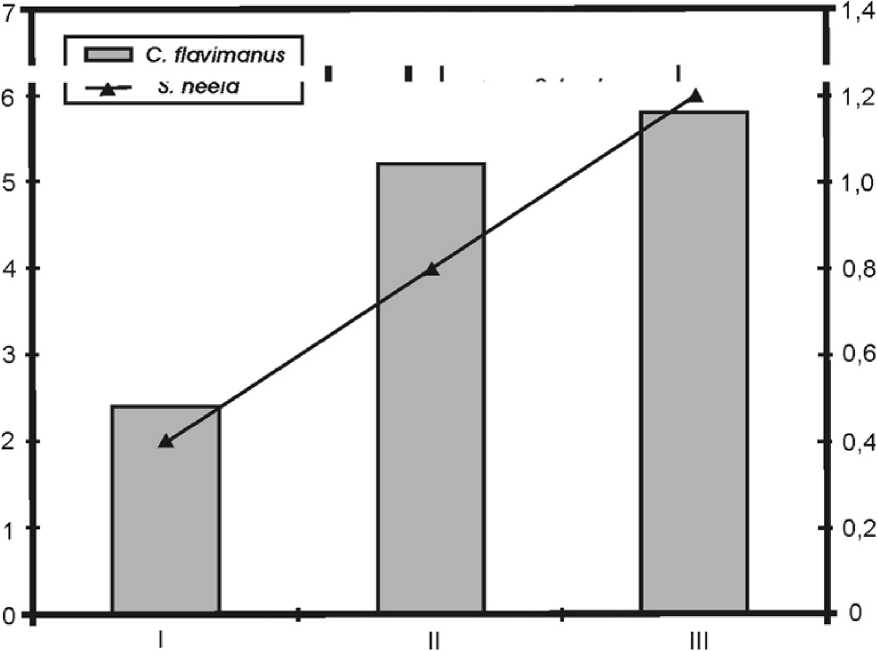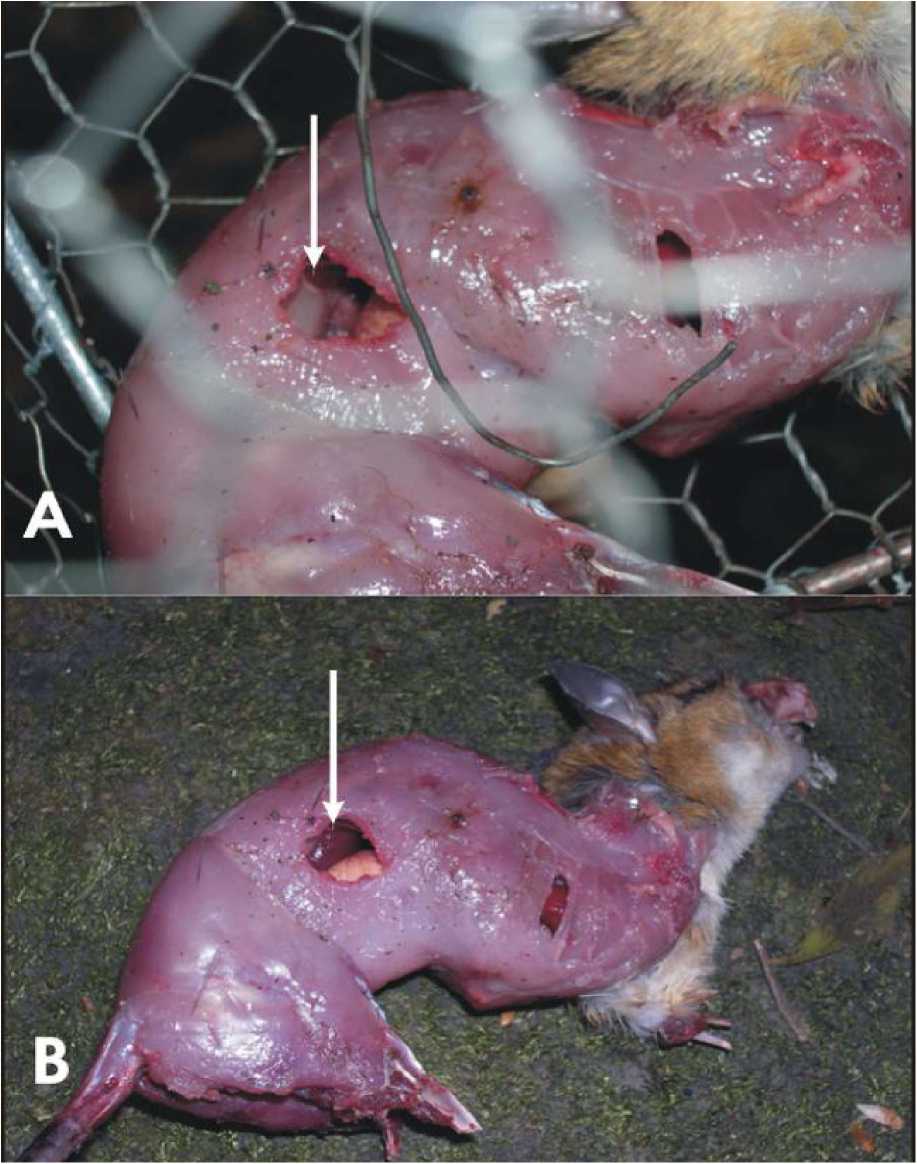Birds hunting rodents: two cases from tropical forests of Southern Vietnam
Автор: Kuznetsov German Vasilyevich, Zinoviev Andrei Valerievich
Журнал: Вестник Тверского государственного университета. Серия: Биология и экология @bio-tversu
Рубрика: Зоология
Статья в выпуске: 1, 2016 года.
Бесплатный доступ
We describe two previously unknown cases of birds hunting rodents in tropical forests of Southern Vietnam. Number of belly-banded squirrels ( Callosciurus flavimanus ), caught in wire traps, shows a strong correlation with the number of crested serpent eagles ( Spilornis cheela ). Oriental pied hornbills ( Anthracoceros albirostris ) hunt red spiny rats ( Maxomys surifer ) over elevated areas of tropical forests.
Vietnam, rodents, birds, hunting
Короткий адрес: https://sciup.org/146116631
IDR: 146116631 | УДК: 598.278+598.279.23+599.322.2+599.323.45
Текст научной статьи Birds hunting rodents: two cases from tropical forests of Southern Vietnam
Introduction. Although relatively small country, Vietnam still remains poorly studied in terms of many aspects of its wildlife. This is especially true for animals inhabiting tropical forests. There are only few works dealing with relations between Vietnamese primates and squirrels

Fig. 1. Map of Vietnam with places of research.
Рис. 1. Карта Вьетнама с местами исследований.
(MacKinnon, 1978, Saiful, Nordin 2001). Data on interactions between mammals and birds is even poorer, despite the great diversity of both groups. Cat Tien National Park (Lam Dong Province) alone harbors a great variety of birds, primates and squirrels (Robson 1991; Fooden, 1996; Polet, Khanh, 1999; Kuznetsov et al., 2002; Polet, Ling, 2004; Kuznetsov, 2006; Kuznetsov, Filatova, 2007). Birds and mammals often inhabit the same stories of the forest, thus entering the concurrent relationships. Studying the spatial distribution of belly-banded squirrels (Callosciurus flavimanus) in Southern Vietnam we observed, that the largest number of squirrels often correlates with the highest number of crested serpent eagles (Spilornis cheela} (Kuznetsov, Filatova, 2008). Ornithologist L.S.
Stepanyan, who conducted studies in 1980s in Buon Luoi Station (Tay ' - 55 - '
Nguyen Plato, Southern Vietnam), has frequently seen crested serpent eagles hunting belly-banded squirrels in the canopy of the forest (Stepanyan, 1995). This study was conducted to prove or dismiss the aforementioned observations. The study also revealed previously unknown relationships between oriental pied hornbills (Anthracoceros albirostris) and red spiny rats (Maxomys surifer).

Fig. 2 . Spatial distribution of belly-banded squirrels and crested serpent eagles along “Afzelia” transect in the tropical forest of Cat Tien National Park (January, 2005). Abscissa axis: numbers of ground traps along the transect; ordinate axis: height of squirrels’ catches and eagles sightings (for 8 daylight hours). The size of circles shows the number of squirrels caught. One star indicates one sighting of the eagle.
Рис. 2 . Пространственное распределение желтолапых белок и хохлатых змееядов вдоль трансекты «Afzelia» в тропическом лесу Национального парка Кат Тьен (январь 2005). Ось абсцисс: число наземных ловушек вдоль трансекты; ось ординат - высота, на которой были пойманы белки и отмечены змееяды (для орлов - за 8-часовой световой день). Размер кружков указывает на количество пойманных зверьков. Одна звездочка обозначает одного змееяда.
Materials and methods. Main studies were carried out in 2005-2007 in tropical forests of Cat Tien National Park (Lam Dong Province) and Binh Chau Reservation (Ba Ria Province) (Fig. 1) along several transects.Transect “Afzelia” in Cat Tien was established along the existing trail, called “Afzelia xylocarpa Trail”. It started in the point with coordinates Nll°26’23,7” and E107°24’54,8” and ended in the point with coordinates Nll°44’00” and Е107°4Г51,9”. Transect was 1500 m in length with an average altitude of 130 m. Upper and middle stories with numerous vines were well represented. Emergent makha trees (Afzelia xylocarpa) of 40-50 m in height dominated the transect. Well-developed crowns of makha trees were populated by the abundance of vines, orchids, ferns and other epiphytes. Other emergents (Lagerstroemia angustifolia, Dipterocarpus dyeri, D. turbinatus, Dalbergia sp.) reached the height of 30-40 m. Closing of leaf canopy at the dry season was estimated from 0.5 to 0.9.

Fig. 3 . Dependence between crested serpent eagles’ sightings and the number of belly-banded squirrels’ catches in tropical forests of Southern Vietnam (2005). Abscissa axis: I - January, Cat Tien National Park (“Afzelia” transect); II - April, Cat Tien National Park (“Afzelia” transect); III - Binh Chau (border transect with the garden and manioc field). Ordinate axis: to the left - number of caught squirrels per 100 traps per day, to the right -average number of eagles’ sightings for 8 daylight hours.
Рис. 3 . Зависимость между наблюдениями хохлатого змееяда и количеством пойманных желтолапых белок в тропических лесах Южного Вьетнама (2005). Ось абсцисс: I - январь, Национальный парк Кат Тьен (трансекта «Afzelia»);
II - апрель, Национальный парк Кат Тьен (трансекта «Afzelia»); III - Бинь Тяу (пограничная трансекта с садом и маниоковым полем).
Ось ординат: слева - число пойманных белок на 100 ловушко/дней, справа - среднее число орлов, встреченных за 8-часовой световой день.
There were many openings of 100-500 sq. m in the forest canopy. They increased the number of habitats suitable for small mammals. Ground traps were placed 25 m from each other; traps above the ground were placed 2-12 m from each other. Belly-banded Squirrel was the only one species caught on this transect. The taxonomic position of captured animals is not yet fully resolved. Some authors include squirrels in Callosciurus erythraeus
(Corbet, Hill, 1992). Further studies of geographical variation within genus Callosciurus are however necessary to draw the final conclusion.
Transect in Binh Chau Reservation was 400 m long. Coordinates of its beginning were N10°33’13,7” and E107°31’33,8”; coordinates of the ending - N10°33’00” and E1070 31’47,7”. Average altitude of Binh Chau Transect was 2 m. Transect was aligned by a complex tropical forest adjacent to the orchards and manioc fields. Three forest stories were well-developed. The largest trees of the families Ebenaceae and Dipterocarpaceae did not exceed the height of 15-20 m. Closing of leaf canopy was 0.4-0.8. Epiphytes were mainly absent due to the low humidity and corresponding aridization of the area. Ground traps were positioned 15 m from each other; traps on trees -2 to 8 m from each other. Squirrels of genera Menetes and Tamiops were caught in addition of the red-bellied squirrels.
Standard bait (manioc + foam-rubber, soaked in sunflower-seed oil) was used to catch squirrels on the ground. Wire traps above the ground were additionally equipped with ladders and bait, which included foam-rubber + manioc and peanuts, soaked in sunflower oil.
Captures were estimated by a number of squirrels caught by 100 wire traps per 24 hours. This index showed the relative density of squirrels in the area. Number of crested serpent eagles was estimated by visual or audio contacts during 8 daylight hours. Data from both sources was used to estimate the numerical dependence between number of squirrels’ captures and eagles’ sightings.
Additional studies have been conducted in a largely disturbed part of the forest in Cat Tien National Park. The linear transect “Lagerstroemia” of 800 m long was established along one of the pathways. It started in the point with coordinates of N11°25’41,3” and E107°25’34,l” and ended in the point with coordinates of N11°25’42,1” and E107°25’21,4”. 40 wire traps were set on the ground. The same number of traps was placed in understorey 2-8 m above the ground. Observations were made in March of 2006 (20 days), in March-April of 2007 (20 days) and in June of 2007 (8 days). The forest in the vicinity of transect had the low level of the closing of leaf canopy (0.3-0.4) with a considerable number of openings due to the selective logging in the past. The average height of the trees was 25-30 m.
Results and Discussion. Crested serpent eagles were often observed on the branches 4-5 m above the ground near the trapped squirrels. Eagles were so attracted by the trapped animals that they allowed to approach very close, up to the distance of 3-5 m. Figure 2 illustrates spatial distribution of caught belly-banded squirrels and data on crested serpent eagles’ sightings in Cat Tien National Park in January of 2005. The largest number of eagles was recorded in the places with the largest number of squirrels’ catches. Studies in April of the same year showed similar situation. The largest number of squirrels’

Fig. 4. Red Spiny Rat, killed, partially skinned and dismembered by the Oriental Pied Hornbill. A - rat’s carcass in the wire trap; В - general view of wounds, inflicted by the hombill through the wire trap. Arrow points the hole, made by the tip of the hornbill’s beak (photos by G.V. Kuznetsov).
Рис. 4 . Желтолапая крыса, убитая, частично ошкуренная и разделанная малабарской птицей-носорогом. А - труп крысы в проволочной ловушке; В - общий вид ран, нанесенных птицей-носорогом через проволочную ловушку. Стрелка указывает на отверстие, сделанное кончиком клюва птицы-носорога (фото Г.В. Кузнецова).
catches in Binh Chau corresponded with the largest number of eagles’ sightings during the entire period of study (Fig. 3). This indicates that Crested Serpent Eagle can be trophically connected to Belly-banded Squirrel. The number of squirrels caught by eagles may not be high, but the constant pressure is sufficient to regulate the size of population.


Fig. 5 . Spatial distribution of red spiny rats catches along “Lagerstroemia” transect in the disturbed tropical forest of Can Tien National Park; above - March 2006, below - March 2007. Abscissa axis: number of ground traps along the transect; ordinate axis - relative altitude of the transect (m). Grey ellipses and arrows indicate numbers of rats, caught along certain distances of the transect (% out of total number). Black crosses indicate rats, killed by oriental pied hornbills in corresponding traps.
Рис. 5 . Пространственное распределение желтолапых крыс, пойманных на трансекте «Lagerstroemia» в нарушенном тропическом лесу Национального парка Кат Тьен; вверху - март 2006 г., внизу - март 2007 г. Ось абсцисс: число наземных ловушек вдоль трансекты; ось ординат - относительный уровень трансекты (м). Серые эллипсы обозначают число крыс, пойманных па определенных участках трансекты (процент от общего числа). Крестиками обозначены крысы, убитые малабарской птицей-носорогом.
The “Lagerstroemia” trail showed the high number of Red Spiny Rat (Maxomys surijery Its distribution varied along the transect. The highest number of catches (70% of total) was in its first half in an elevated area with tuff boulders and numerous rats’ holes. 25 individuals per 100 traps per 24 hours were caught here in the first week of March of 2006. This is 10 times more than for any other part of Cat Tien. The higher concentration of rats in this area was related to the flood during the wet season in August, when rodents concentrated on the elevated non-flooded areas. There we recorded the activity of initially unknown predator, which killed the rats in wire traps. Killed rats were skinned and dismembered (Fig. 4). Wire traps were not open and did not show any traces of breakage or intrusion. They were often moved to the more open place 2-10 m from the original position. 8 rats were killed this way during 20 days. This constitutes 25% out of all catches on the transect. As the result this predator’s activity, the number of rats was lowered to 3.9 individuals per 100 traps per day. This is the average value for the transect
Enigmatic kills were also observed in March-April of the next year. They did not changed significantly the number of rats on the transect. However, the distribution of rat along the transect became more even, Their slightly higher number on the elevations still attracted the predator, though this time we recorded only three kills in wire traps (Fig. 5). Further observations revealed an enigmatic predator. It was Oriental Pied Hornbill ^Anthracoceros albirostris\ Groups of these birds were often seen and heard in the vicinity of the transect. Holes, left in bodies of killed rats, matched the size of the tip of hornbill’s beak (Fig. 4). Asian hornbills, besides eating fruits, are known to consume animal food. Inspection of nests of four hornbill species in Thailand have brought remains a variety of mammals, such as bats, squirrels and rodents (Kemp, 2001). Our observations were made during the breeding season of Oriental Pied Hornbill, which lasts from January to June (Robson, 2000). Rats, caught in traps, were undoubtedly attractive food items for hornbills to bring to their nestlings. Kills were also recorded in dry season, when the forest largely devoid of ripe fruits.
Conclusion. Although interactions between birds and rodents in tropical forests of some areas of Southeast Asia are well-studied (for an overview see Kemp, 2001), the corresponding data from tropical forests of Vietnam is largely missing. Our studies in tropical forests of Southern Vietnam revealed two previously unknown cases of interactions between birds and rodents. Crested serpent eagles hunt belly-banded squirrels, thus regulating their number in some forested areas of Southern Vietnam. Primarily frugivorous oriental pied hornbills add to their diet red spiny rats as a food for nestlings or adult birds during the dry season.
Acknowledgements. We are grateful to the directorate and staff of Vietnam-Russia Tropical Centre, who greatly helped us in our studies: V.S. Roumak, Trinh Quoc Khanh, Nguyen Hong Du, A.N. Kuznetsov, M.V. Kalyakin, L.P. Kourzun, A.V. Borissenko and others. We also would like to thank the directorate and staff of Can Tien National Park for hospitable acceptance: Tran Van Thanh, Pham Huu Khanh and many others. Our thanks to all the colleagues who helped us on the course of field studies in Southern Vietnam.
Кузнецов Г.В. Охота птиц на грызунов: два случая из тропических лесов южного Вьетнама / Г.В. Кузнецов, А.В. Зиновьев // Вести. ТвГУ. Сер.: Биология и экология. 2016. № 1. С. 55-63 (in English).
Список литературы Birds hunting rodents: two cases from tropical forests of Southern Vietnam
- Corbet G.B., Hill J.E. 1992. The mammals of the Indonesian region: a systematic review. Oxford: University Press. 488 p.
- Fooden J. 1996. Zoogeography of Vietnamese primates//International Journal of Primatology. V. 17. No. 5. P. 845-899.
- Kemp A.C. 2001. Family Bucerotidae (Hornbills)//Handbook of the Birds of the World. Volume 6: Mousebirds to Hornbills. Spain: Lynx Edicions. V. 6. P. 436-523.
- Kuznetsov A.N. Su Van Khoi, Vasiliev B.D., Phan Luong, Borissenko A.V., Nguyen Van Thinh, Bobrov V.V., Zinoviev A.V. 2002. Results of complex zoological-botanical expedition in Cat Loc, Cat Tien National Park. Hochiminh: Vietnam-Russia Tropical Centre and Cat Tien National Park Conservation Project. Technical Report. V. 36. 64 p.
- Kuznetsov G.V. 2006. Mammals of Vietnam. Moscow: KMK Scientific Press Ltd..
- Kuznetsov G.V., Filatova T.N. 2007. Rodent community in tropical forests in South Vietnam: comparative ecology of two dominant species and implications for conservation//Integrative Zoology. V. 2. No. 3. P. 136-143.
- Kuznetsov G.V., Filatova T.N. 2008. On the abundance and spatial distribution of Callosciurus flavimanus in tropical forests of southern Vietnam//Zoologichesky Zhurnal. V. 87. P. 601-608.
- MacKinnon K.S. 1978. Stratification and feeding differences among Malayan squirrels//Malayan Nature Journal. V. 30. P. 593-608.
- Polet G., Ling S. 2004. Protecting mammal diversity: opportunities and constraints for pragmatic conservation management in Cat Tien National Park, Vietnam//Oryx. V. 38. № 2. P. 1-11.
- Polet G., Pham Huu Khanh. 1999. Birds of Cat Tien National Park. Vietnam: Nha Xuat ban TP Ho Chi Minh. 48 p. (in Vietnamese).
- Robson C.R. 1991. The avifauna of Nam Cat Tien national Park, Dong Nai//Garrulax. V. 8. P. 4-9.
- Robson C.R. 2000. A field guide to the birds of South-East Asia. Thailand, Peninsular Malaysia, Singapore, Myanmar, Laos, Vietnam, Cambodia. UK: New Holland Publishers. 504 p.
- Saiful A.A., Nordin M. 2004. Diversity and density of diurnal squirrels in a primary hill dipterocarp forest, Malaysia//Journal of Tropical Ecology. V. 20. P. 45-49.
- Stepanyan L.S. 1995. Birds of Vietnam: based on the investigations of 1978-1990. Moscow: Nauka. 448 p..


